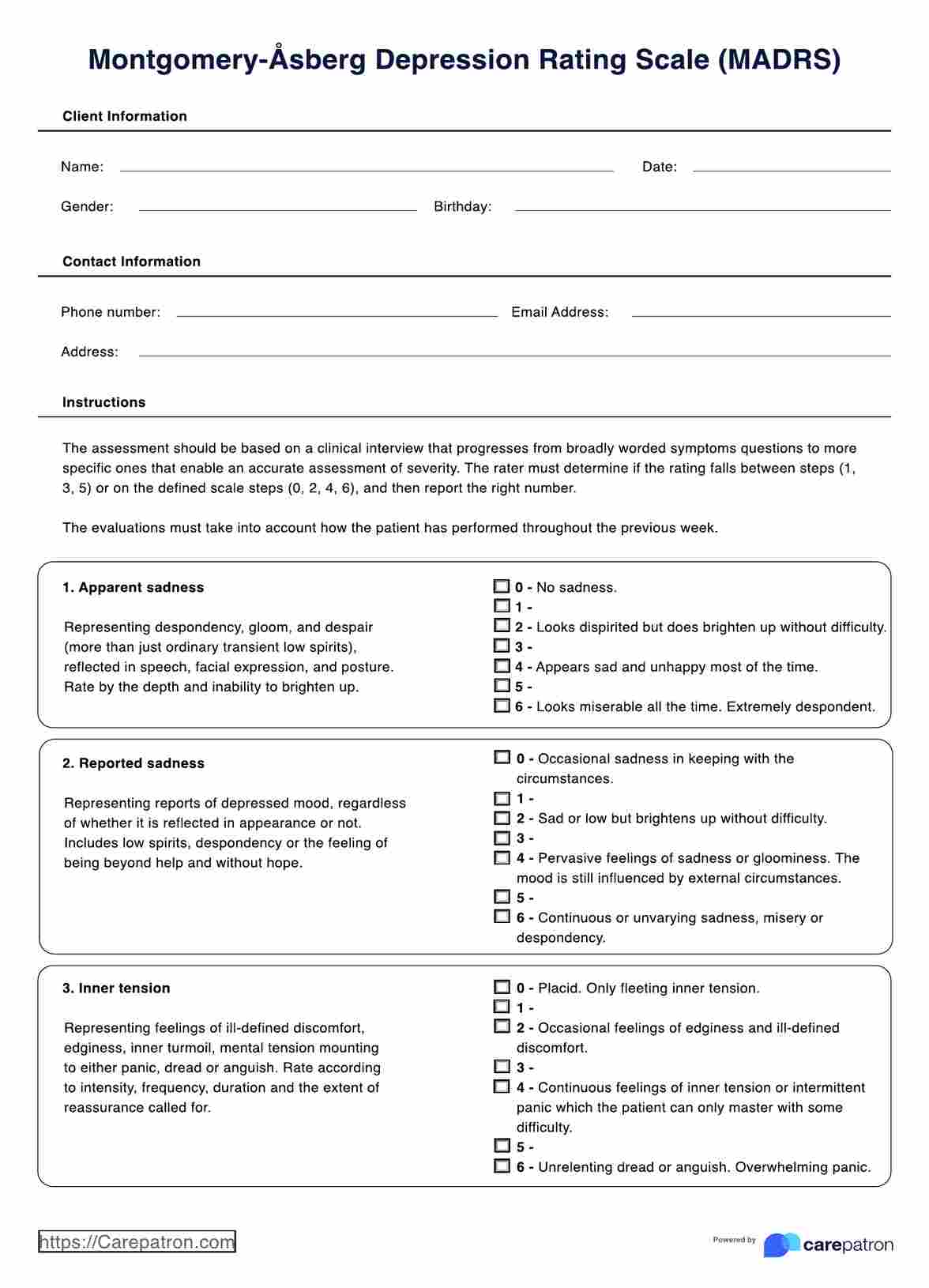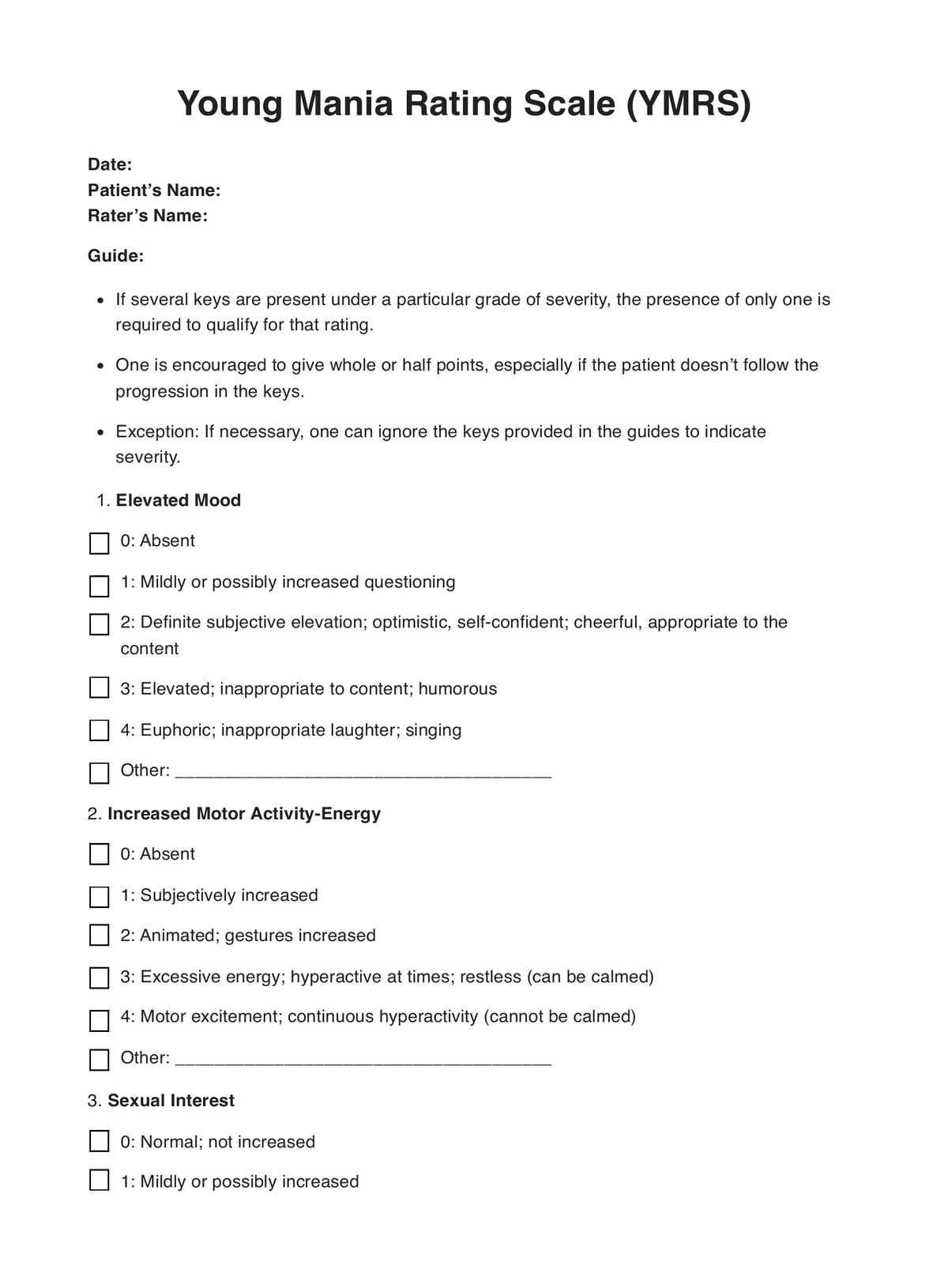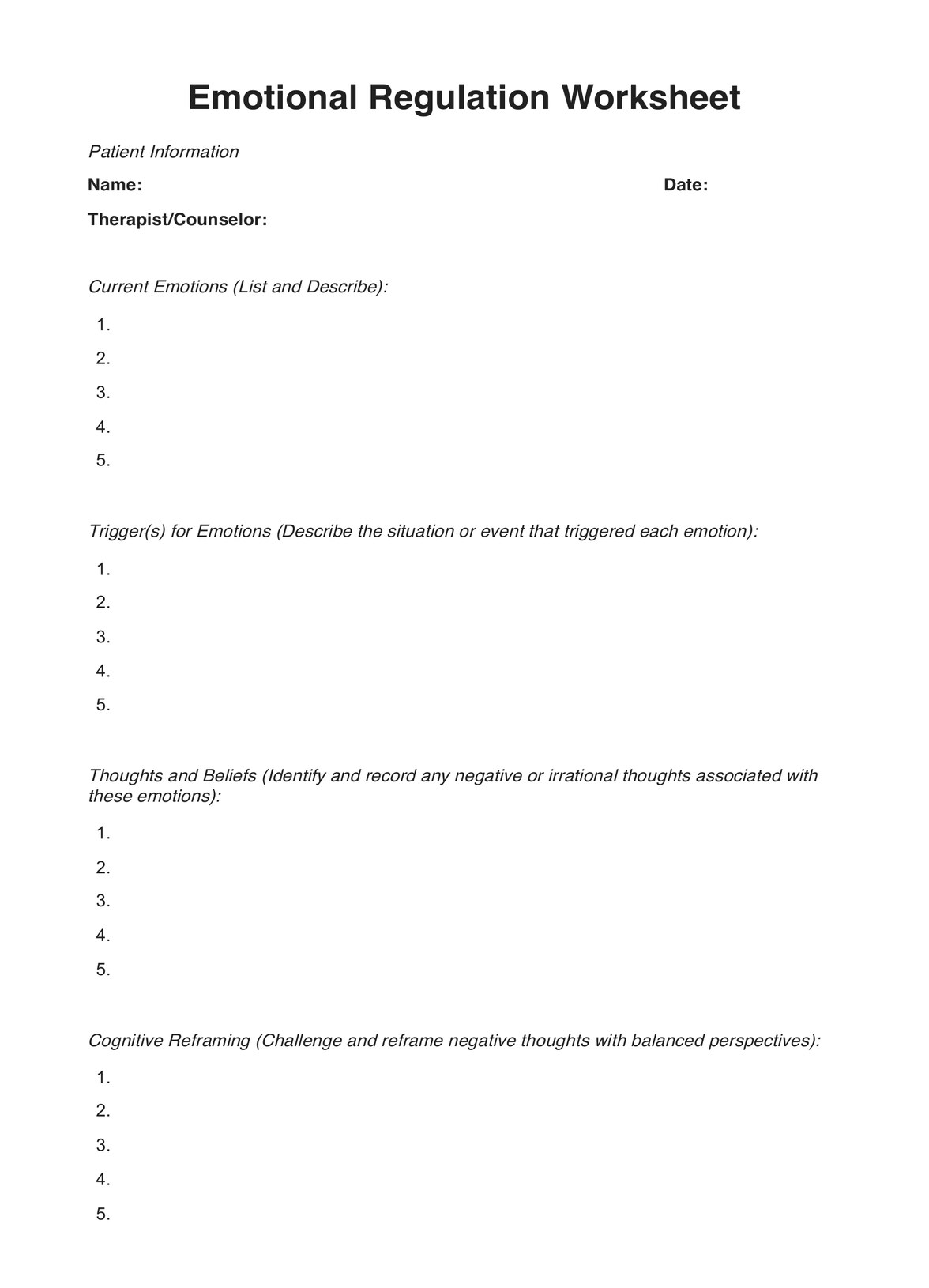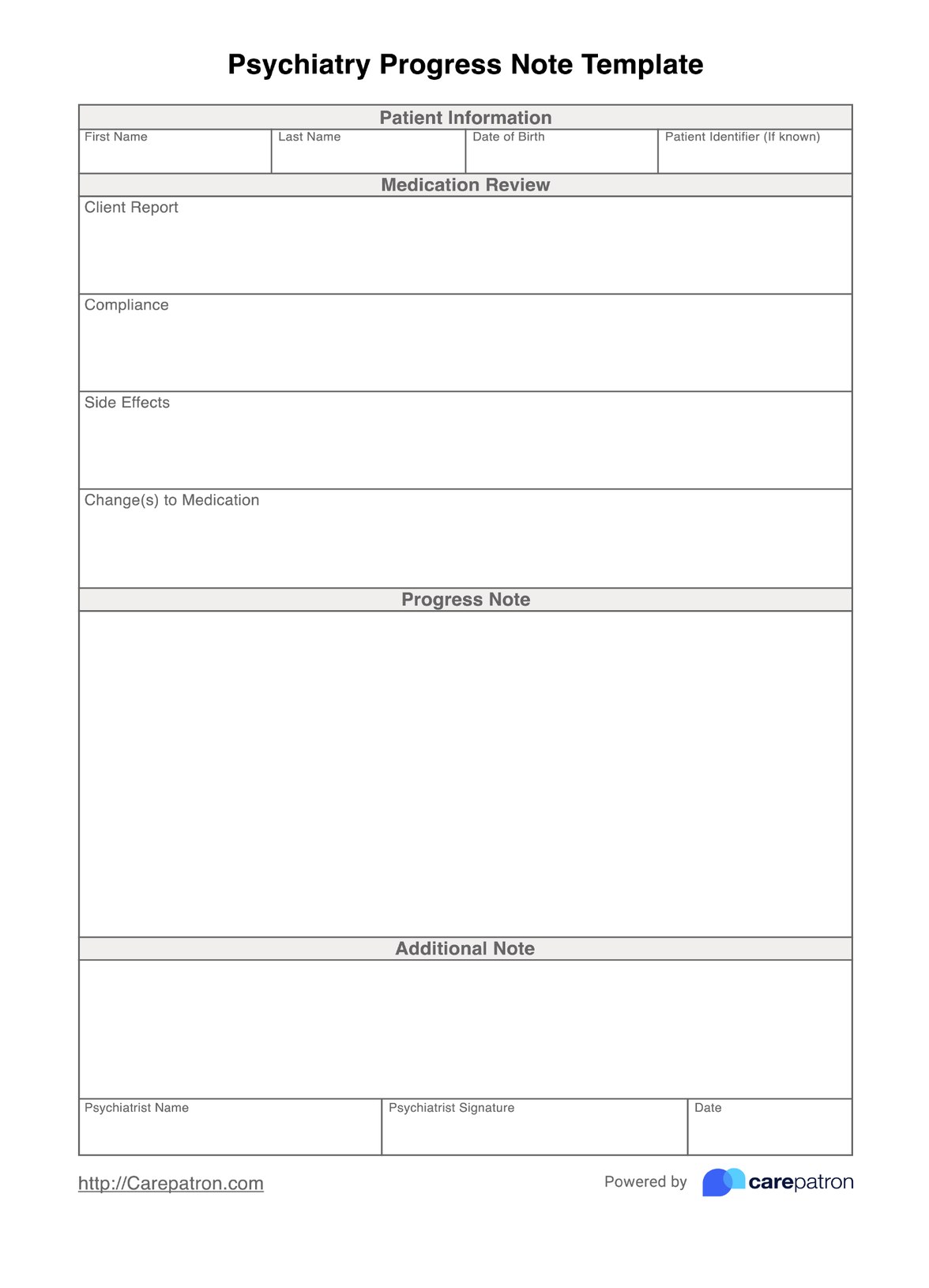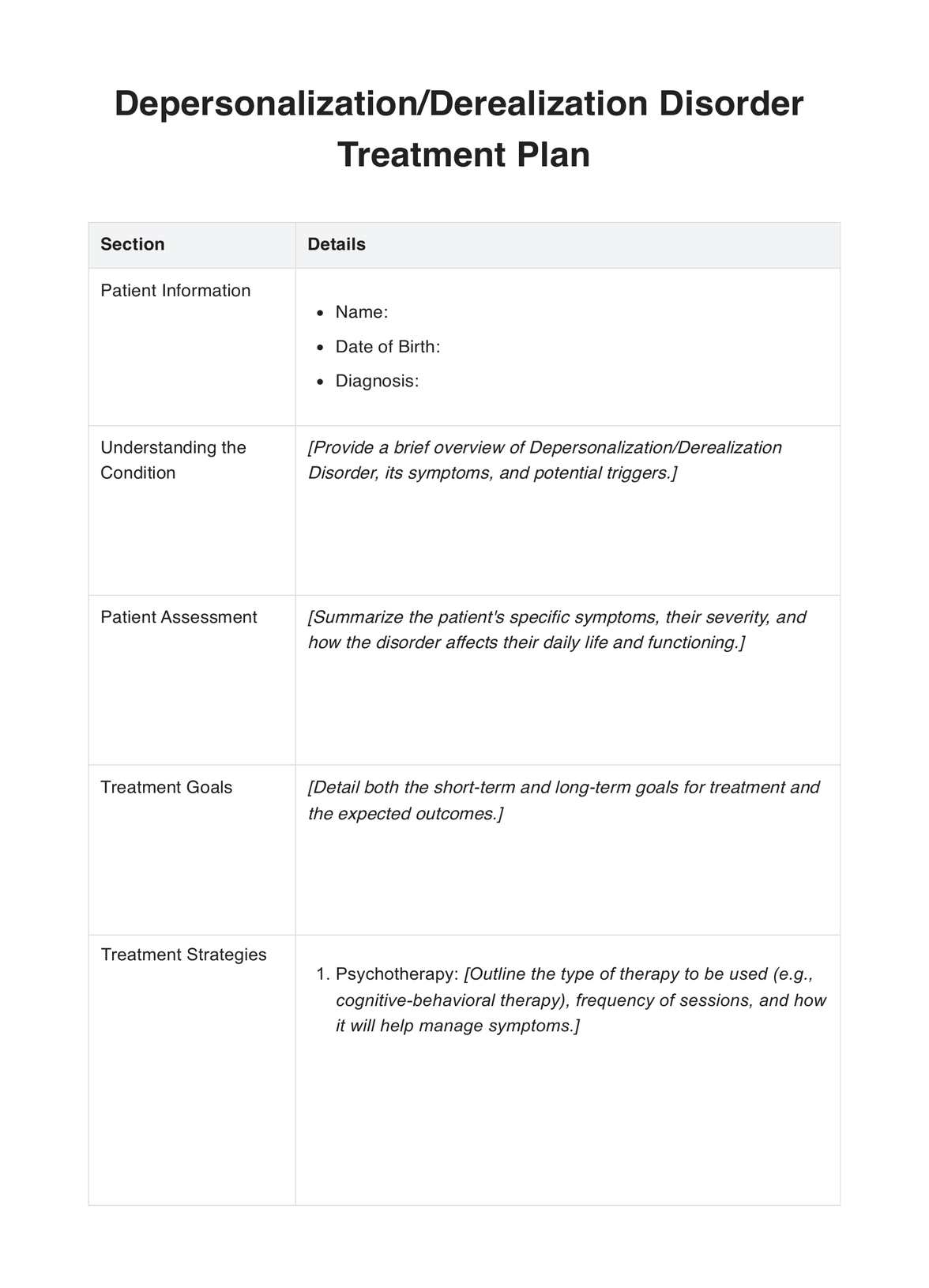RAADS-R Test Scoring
Obtain accurate RAADS-R Test Scoring results to effectively assess autistic traits and behaviors, aiding in diagnosis and personalized interventions.


What is a RAADS-R Test Scoring?
The RAADS-R (Ritvo Autism Asperger Diagnostic Scale-Revised) Test Scoring is a crucial tool in autism spectrum disorder (ASD) assessment. Developed by Dr. Eric R. Ritvo and his colleagues, this self-report questionnaire is designed to help clinicians, researchers, and individuals better understand and evaluate the presence and severity of autistic traits and behaviors in adults.
The test consists of 80 questions that cover various aspects of social interaction, communication, and repetitive behaviors—core domains associated with ASD. Respondents rate their agreement with each statement on a 4-point scale. Higher scores on the RAADS-R indicate a higher likelihood of autism-related traits or behaviors. The questions are structured to assess the presence and degree of these traits, making it a valuable tool for diagnosing and evaluating the severity of ASD.
The scoring process involves summing the individual responses to each question to obtain a total score ranging from 0 to 240. Additionally, the test provides subscale scores for social relatedness, language, sensory/motor issues, and circumscribed interests. These subscales help clinicians better understand the specific areas where an individual may exhibit autistic traits.
The is instrumental in clinical practice for diagnosing autism in adults, assessing the extent of autistic traits, and monitoring changes in behavior over time. It is also used in research to study the prevalence and characteristics of ASD in various populations. The results of the RAADS-R can guide the development of personalized interventions and support strategies for individuals on the autism spectrum.
RAADS-R Test Scoring Template
RAADS-R Test Scoring Example
How to use the RAADS-R Test Scoring
Access a Printable RAADS-R Form
Start by obtaining a printable RAADS-R form. You can often find official test versions online through reputable sources, such as Carepatron, academic institutions or healthcare organizations.
Review the Instructions
Carefully read the instructions provided with the RAADS-R form. These instructions typically include an explanation of the scoring process and guidance on completing the questionnaire.
Set the Environment
Choose a quiet and comfortable environment for the individual taking the test. Minimize distractions to ensure accurate responses.
Self-Assessment
The RAADS-R is a self-report questionnaire, meaning the individual being assessed will answer the questions themselves. It's essential that they respond honestly and to the best of their ability.
Rate Each Statement
The form contains 80 statements about social interaction, communication, and repetitive behaviors. The individual should rate their agreement with each statement on a 4-point scale:
- 0 = "Never True"
- 1 = "Rarely True"
- 2 = "True Often"
- 3 = "Almost Always True"
Sum the Scores
After completing all the questions, add the scores for each response. The total score can range from 0 to 240, with higher scores indicating a higher likelihood of autistic traits.
Assess Subscale Scores
Besides the total score, the RAADS-R provides subscale scores for social relatedness, language, sensory/motor issues, and circumscribed interests. These scores can offer insights into specific areas of concern.
Interpret the Results
Interpret the scores in the context of autism diagnosis and assessment. Higher total scores and elevated subscale scores may suggest a more significant presence and severity of autistic traits.
Consult a Professional
While the RAADS-R is a valuable tool, more than a formal diagnosis is needed by a qualified healthcare professional. If the results indicate a likelihood of autism, seek further evaluation and consultation from a healthcare provider or psychologist.
Document and Discuss Findings
Document the RAADS-R scores and discuss them with the individual being assessed or their caregiver. This information can guide treatment plans and support strategies if needed.
RAADS-R Test Scoring Interpretation
Interpreting RAADS-R (Ritvo Autism Asperger Diagnostic Scale-Revised), Test Scores are crucial in understanding an individual's likelihood of having autistic traits and behaviors. The interpretation process involves analyzing the total and subscale scores to gain a comprehensive understanding. Here's how to interpret RAADS-R scores:
- Total Score: The total score on the RAADS-R can range from 0 to 240, with higher scores indicating a higher likelihood of autistic traits. Interpretation of the total score typically follows these guidelines:
- 0-65: Generally considered within the typical range, suggesting fewer autistic traits.
- 66-90: A score in this range may indicate mild to moderate autistic traits.
- 91 and above: Higher scores often suggest a significant presence of autistic traits, which may warrant further evaluation by a healthcare professional.
- Subscale Scores: RAADS-R provides subscale scores in four domains: social relatedness, language, sensory/motor issues, and circumscribed interests. These subscale scores offer insights into specific areas of concern:
- Social Relatedness: High scores in this domain may indicate social interaction and communication challenges.
- Language: Elevated scores suggest difficulties in understanding and using language effectively.
- Sensory/Motor Issues: Higher scores may indicate heightened sensitivities or motor coordination challenges.
- Circumscribed Interests: Elevated scores in this area imply a strong focus on specific, often repetitive, interests.
It's important to note that while RAADS-R scores can provide valuable insights, they should not replace a formal diagnosis by a qualified healthcare professional. The scores should be interpreted in consultation with a healthcare provider who can consider other factors, conduct further assessments, and provide guidance on appropriate interventions and support.
Interpreting RAADS-R Test Scores is a valuable tool for self-awareness and initial assessment, ultimately leading to more informed decisions regarding autism-related concerns and potential next steps in seeking diagnosis and support.
Benefits
Early Detection
RAADS-R facilitates the early identification of autistic traits and behaviors in adults, allowing for timely interventions that can significantly improve outcomes.
Accurate Assessment
This standardized assessment tool ensures a consistent and precise evaluation of autism-related traits, reducing the risk of misdiagnosis and ensuring that individuals receive the appropriate support.
Personal Insight
Completing the RAADS-R questionnaire gives individuals deep self-insight into their behaviors, fostering self-awareness and understanding of their unique characteristics.
Informed Decision-Making
The test results empower individuals and healthcare professionals to make informed decisions regarding further assessments, therapy, and support services, optimizing the path to improved well-being.
Tailored Interventions
RAADS-R scores help clinicians and caregivers develop highly individualized intervention and support strategies based on an individual's specific trait profile, ensuring more effective assistance.
Support for Research
RAADS-R is an invaluable tool for researchers, providing a quantifiable measure of autistic traits in adults, advancing knowledge about autism spectrum disorders, and leading to improved treatments and interventions.
Diagnostic Aid
Healthcare professionals can use RAADS-R as a supplementary diagnostic aid, offering a quantitative assessment of autistic traits alongside clinical evaluation, contributing to a more accurate diagnosis.
Progress Monitoring
Professionals can employ the test to track changes in behaviors over time, enabling them to assess the effectiveness of interventions and adjust strategies as needed.
Increased Awareness
RAADS-R raises awareness about autism spectrum disorders and the diverse ways they manifest in adults, fostering a better understanding of this complex condition.
Reduced Stigma
By offering an objective and data-driven assessment, RAADS-R helps reduce stigma and dispel misconceptions surrounding autism, promoting a more inclusive and empathetic society.
Access to Resources
Free RAADS-R Test Scorings ensures this valuable assessment tool is accessible to a broader audience, promoting its use in diverse settings and communities.
Improved Support
Ultimately, using RAADS-R leads to improved support structures and a higher quality of life for individuals with autistic traits, facilitating their integration into society and enhancing their overall well-being.
Research & Evidence
The RAADS-R (Ritvo Autism Asperger Diagnostic Scale-Revised) is a well-established resource in the field of autism spectrum disorder (ASD) assessment, backed by a history of research and evidence that supports its utility.
The development of the RAADS-R can be traced back to the early 2000s. Dr. Eric R. Ritvo and his colleagues aimed to create a comprehensive and reliable self-report questionnaire to assess autistic traits and behaviors in adults. The initial version of the RAADS was introduced in 2008. It underwent subsequent revisions and refinements to enhance its accuracy and effectiveness. The revised version, RAADS-R, was published in 2011, incorporating feedback and insights from clinicians, researchers, and individuals with ASD.
The RAADS-R has undergone extensive psychometric testing to ensure its reliability and validity. This involved assessing its consistency, repeatability, and its ability to measure autistic traits accurately. Numerous research studies have used the RAADS-R to explore the prevalence and characteristics of ASD in various populations. This has contributed to a deeper understanding of how autism presents in adults.
The questionnaire's scores have been correlated with other established measures of autism, demonstrating its convergent validity. In other words, it aligns well with existing diagnostic criteria and assessments. Clinicians and researchers have utilized the RAADS-R as part of comprehensive diagnostic evaluations for adults suspected of having ASD. Its effectiveness in aiding diagnosis and guiding interventions has been documented in clinical practice. The availability of free RAADS-R Test Scorings online has made it a widely accessible resource for individuals and professionals, further promoting its use and the collection of valuable data for research purposes.
References
Anthony, J. (2023, July 20). RAADS-R Autism Testing | Questions - Answers | ABA Centers of America. ABA Centers of America. https://www.abacenters.com/raads-r-test-for-autism/
Hegarty, D. (2023, February 27). Ritvo Autism Asperger Diagnostic Scale – Revised (RAADS-R). NovoPsych. https://novopsych.com.au/assessments/diagnosis/ritvo-autism-asperger-diagnostic-scale-revised-raads-r/#:~:text=Scoring%20and%20Interpretation,65%20are%20consistent%20with%20Autism.
Jones, N. E. E. S. &. K. (2020). RAADS–R. Embrace Autism. https://embrace-autism.com/raads-r/
Jones, S. L., Johnson, M., Alty, B., & Adamou, M. (2021). The effectiveness of RAADS-R as a screening tool for adult ASD populations. Autism Research and Treatment, 2021, 1–6. https://doi.org/10.1155/2021/9974791
RAADS-R Autism Online Test questionnaire & PDF | AutisticHub. (2023, June 21). AutisticHub. https://www.autistichub.com/raads-r-autism-online-test-questionnaire-pdf/
Ritvo, R. A., Ritvo, E., Guthrie, D., Ritvo, M. J., Hufnagel, D., McMahon, W. M., Tonge, B. J., Mataix‐Cols, D., Jassi, A., Attwood, T., & Eloff, J. (2010). The RITVO Autism Asperger Diagnostic Scale-Revised (RAADS-R): A scale to Assist the diagnosis of autism Spectrum Disorder in Adults: an International Validation study. Journal of Autism and Developmental Disorders, 41(8), 1076–1089. https://doi.org/10.1007/s10803-010-1133-5
Zauderer, S. (2023). RAADS-R Test: RITVo Autism Asperger Diagnostic Scale-Revised. www.crossrivertherapy.com. https://www.crossrivertherapy.com/autism/raads-r-test
Commonly asked questions
Individuals themselves or healthcare professionals can score a RAADS-R.
A RAADS-R is typically scored after an individual completes the self-report questionnaire, which assesses autistic traits and behaviors.
RAADS-R Test Scorings are used to evaluate the presence and severity of autistic traits in adults for diagnostic, research, and intervention purposes.
A RAADS-R score can assist in the early detection of autism, inform treatment decisions, guide personalized interventions, and support research in autism spectrum disorders.


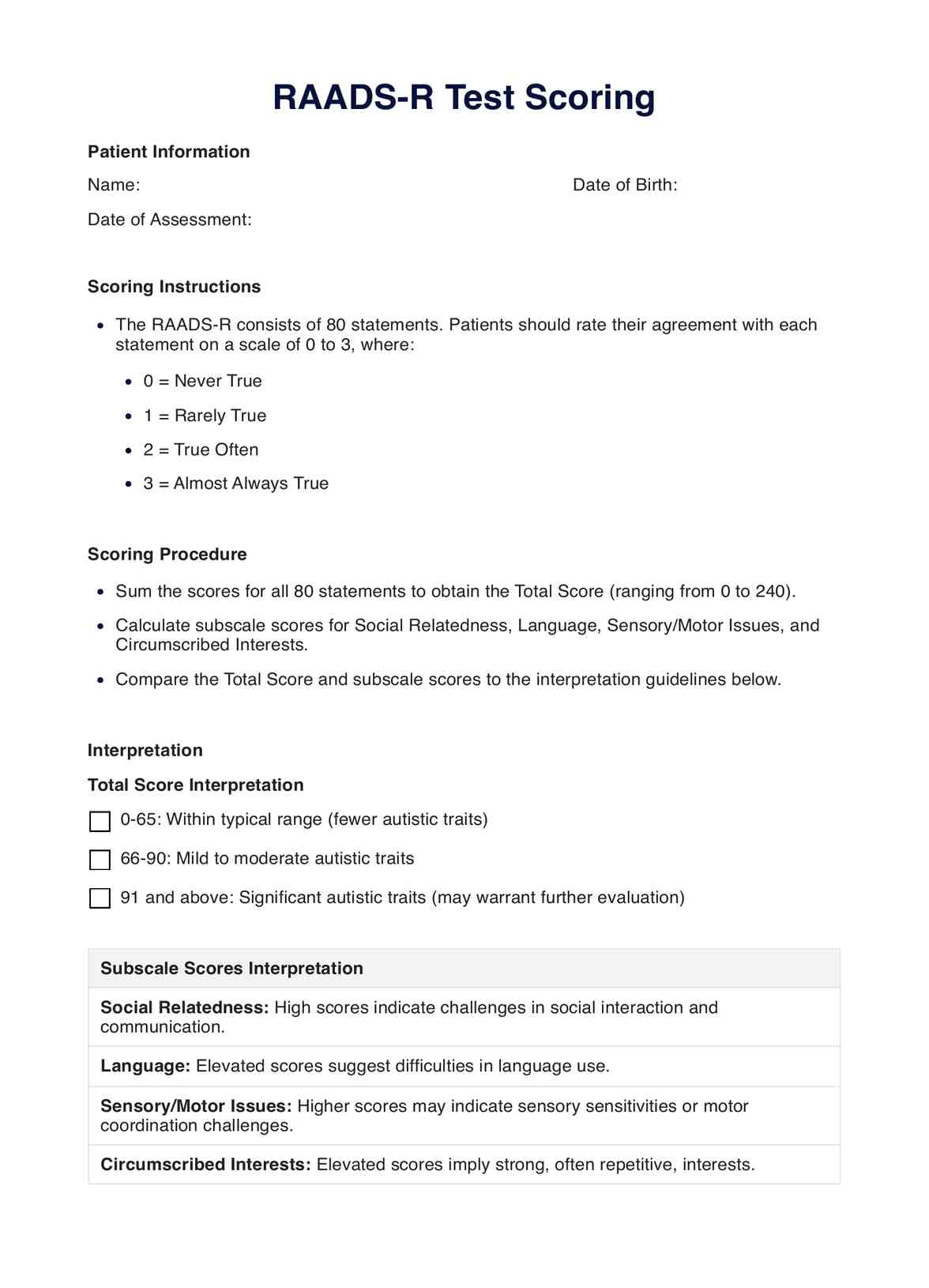
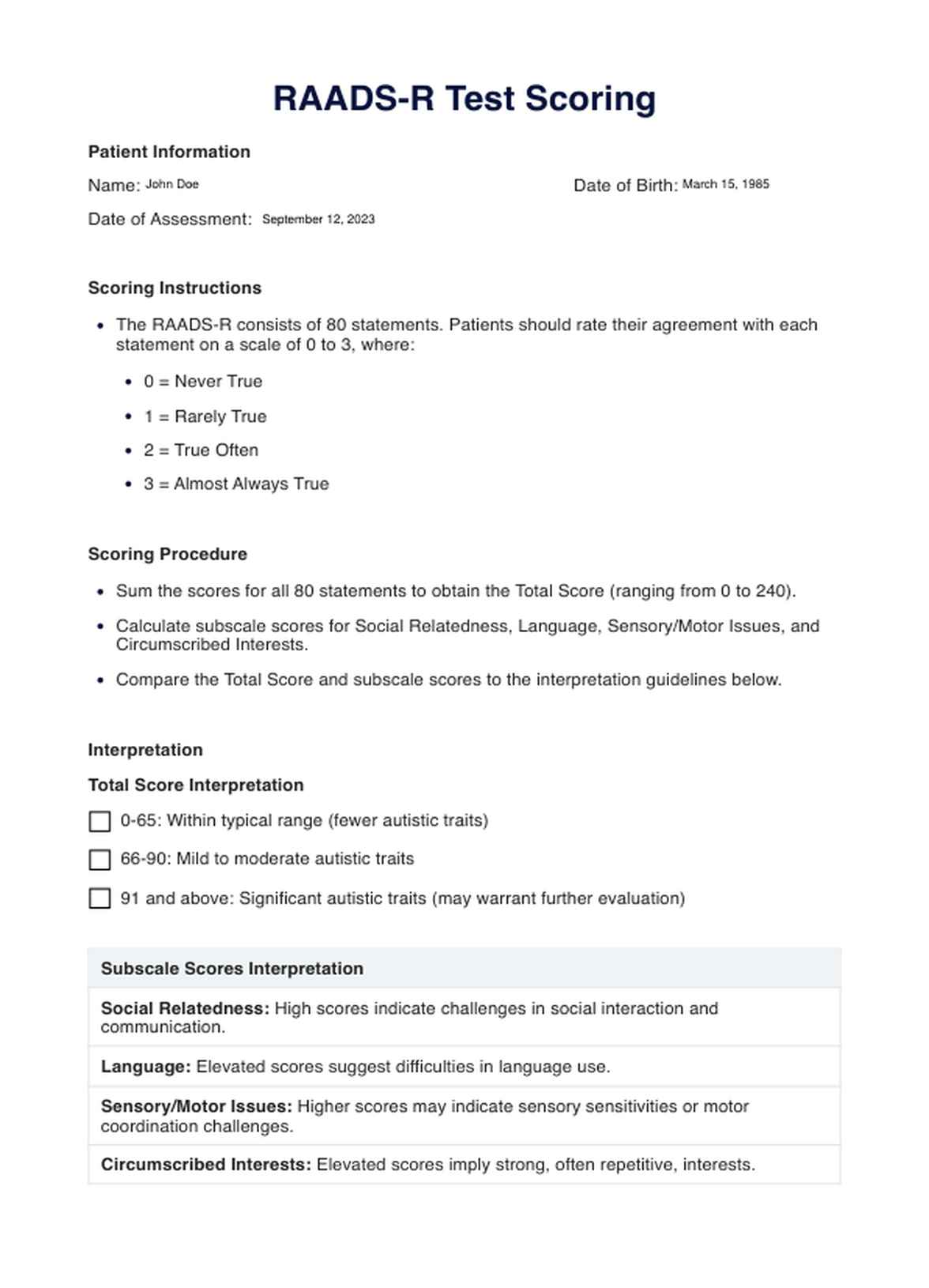




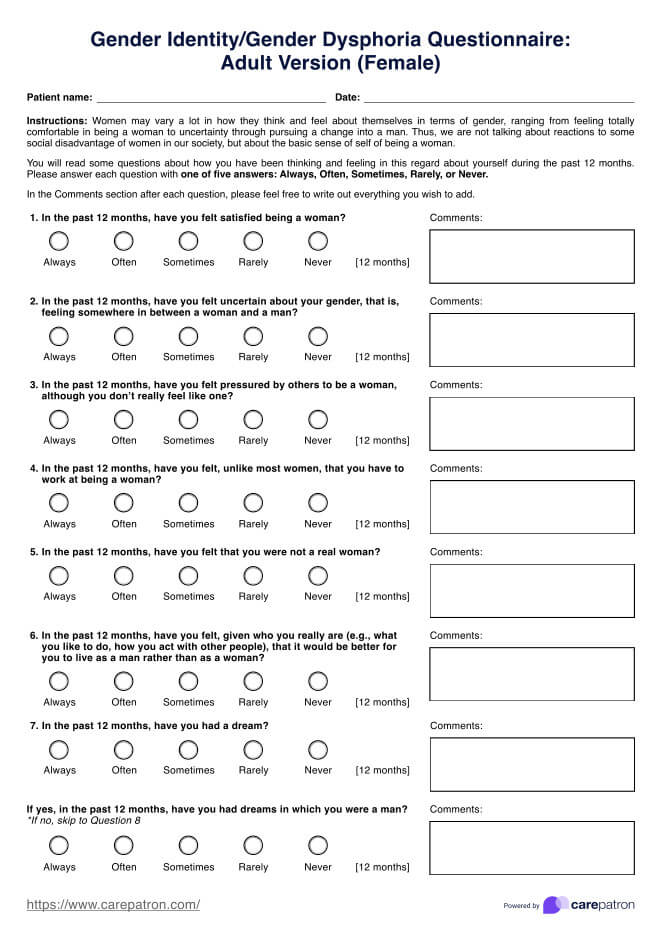









-template.jpg)























































































